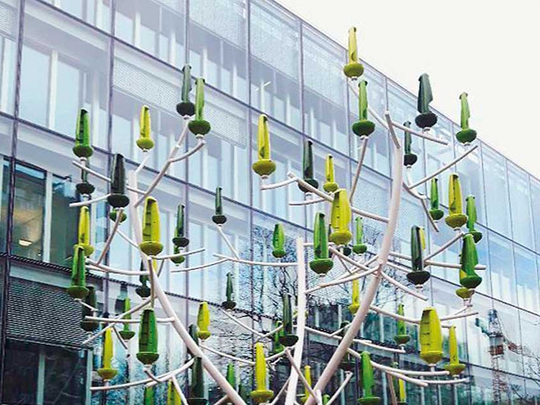
Fyodor Dostoyevsky no doubt had other things in mind when, in his famous novel The Idiot, he wrote that “beauty will save the world.” And yet, a century and a half later, those words have much to say about the current state of green energy technologies.
Simply put, we need energy alternatives to save our planet. But to encourage more people to embrace them, we also need to focus on aesthetics. We need to make them more beautiful, in other words. Because honestly, is anything more unseemly than a massive hydroelectric dam, solar panels fixed awkwardly onto a roof or rows of wind turbines breaking up the countryside? It’s as if such energy alternatives have to be ugly to be taken seriously.
People already recognise the need for these technologies — to counter depleting natural resources, reduce pollution and limit global warming. Imagine, then, if renewable energy generators were easier on the eyes; if besides being efficient, rational and functional, they were also aesthetically pleasing. Remember, without beauty’s grace, people feel neither desire nor attachment.
The problem has much to do with the age-old antagonisms between engineers and artists, meaning designers, architects or any creator of forms. Technicians and artists don’t speak the same language. Nor do they have the same expectations or work at the same speed.
They think differently, and so struggle to understand each other. An engineer rationalises, quantifies and resolves problems in a precise framework. An artist looks beyond the framework, seeking forms, symbols and meanings that are more than just functional.
Attempts have been made to bridge the two worlds. But so far, the results are often counterproductive. A prime example is the wind tree installed in 2016 outside a Geneva bank. Designed as an urban generator, the tree’s leaves produce energy when they sway. True, it’s an elegant contraption. Only it doesn’t really work, at least not as a wind turbine. Its leaves turn very little, the power yield is feeble, and the French firm that created the tree went bust last year.
The glass front of the SwissTech Convention Center in Lausanne is another example. The facade is made of translucent solar panels tinted red, green and orange. Very interesting, from a visual standpoint, but again the energy the panels produce is meagre. It’s another case of beautiful thwarting useful.
Still, there are some exceptions. One is the Swiss Solar House, which won the US Department of Energy’s Solar Decathlon prize last October in Denver, Colorado.
Like other successful attempts to combine beauty and functionality, the Swiss Solar House was the product of close collaboration, from the outset, between artists and engineers.
To integrate their efforts, the two teams had to share a common vision and speak a sort of common language.
The experimental project, which involved people from several Swiss technical institutions, was headed by Marilyne Anderson of Lausanne’s Ecole Polytechnique fédérale (EPFL). “[Until recently] the debate focused on energetic performance at the expense of aesthetics,” Anderson explains. “In fact, a schism arose between those talking sustainability and those concerned with construction quality.”
Artistry in motion
Green automobiles have also suffered from a beauty deficit or, more specifically, from an overly conservative design approach. Car designers are beholden to their traditions and told not to be too bold given the huge amounts of money at stake. They take their lead, in other words, from technicians and accountants.
But even there, things are shifting. At the recent Detroit automobile show, some designers spoke openly about aesthetics. Alfonso Albaisa, Nissan’s vice-president for global design, talked about the artistry of the Xmotion — an SUV prototype with a smooth, wood-crafted cockpit — and the QX Inspiration, one of its Infiniti-line luxury models.
Karim Habib, head of design at Infiniti, mentioned that he’d studied art in Switzerland. He took sculpture, painting and architecture classes — all of which were key to his training as an industrial designer, he said. Habib recalled one particular class taught by a professor trained at the typography school in Basel. “For the first time in my life, I understood the importance of proportions, the balance between fineness and thickness,” he said. “I learned a whole lot.”
Another sign of change is that art schools have begun winning automobile design contests. Last year, two students of the Academy of Fine Arts in Krakow, Poland won one of the Innovation Challenge prizes awarded by the French automotive supplier Valeo. About 5,000 students from 750 universities — most of them, technical institutions — participated in the contest.
The Krakow students designed an elegant, self-driving electric car that can function as both a passenger and delivery vehicle, and sever as a sleeping pod. They were the first Valeo winners to come from the fine arts rather than an engineering school. Given the way things are going, they may not be the last. And who knows, perhaps one day, beauty — rather than blah — will become the defining characteristic of sustainability.
–Worldcrunch/New York Times News Service













